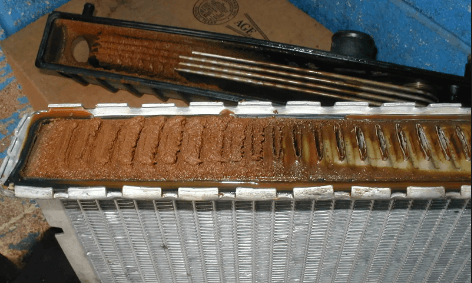5 Signs of clogged radiator
The radiator is a part of the car engine cooling system. It is used to release the heat inside the coolant out to the open air. The hot coolant from the engine flows through the radiator, passing the upper tank, radiator core pipes, and the lower tank.
Inside the core pipes, the heat absorbs by the fresh air and cooling down its temperature. After the coolant temperature is cooling down, the coolant starts to enter the engine over again to absorb the heat generated by the engine.
A clogged radiator is commonly caused due to the old coolant or a cooling system that hasn’t been serviced and flushed regularly. The coolant invites sediments and rust that blocks the radiator pipes and fins.
Suppose the radiator blocked, it fails to cool down the coolant temperature. In that case, the engine will overheat and cause massive damage inside the engine. Radiator blocked is one of many examples of radiator failures.
This article will give information about the five signs of the clogged radiator so you can alert yourself for car cooling system check and repair as soon as possible. Read the five signs of clogged radiator below.
1. Engine temperature is rising and tends to overheat
The first sign of a radiator blocked is when your engine temperature is rising and tends to overheat. A clogged radiator makes the coolant flow from the engine to the radiator (and vice versa) are blocked.
The only way for coolant to flow is through the bypass hose and back again to the engine. In this case, the coolant temperature is hot, and there is no cooler coolant used to absorb the heat were generated by the engine. As a result, the engine temperature is rising and tends to overheat.
2. Overflowing coolant in radiator reservoir tank
The next sign of a radiator blocked is when the coolant inside the radiator reservoir tank is overflowing. The reservoir tank looks full of coolant and is overflowing, moreover when the engine is running.
It can happen because the overpressure valve on the radiator cap is always open. Yes, when the air pressure inside the cooling system exceeds the pressure valve specification, the radiator cap pressure valve will open. This condition makes the coolant flow to the reservoir tank.
3. Radiator motor fan spinning over time
A clogged radiator usually brings the radiator motor fan spinning over time and longer than normal conditions. When the radiator blocked, the coolant only circulates inside the engine, and the engine temperature won't cooling down.
The engine coolant temperature sensor reads the coolant temperature and sends the data to the engine control module. Because the engine control module reads the coolant temperature is in a hot position, the engine control module controls the radiator motor fan to spin until the temperature is cooling down.
Because the radiator blocked and the temperature is always hot, the engine will continuously spin the radiator motor fan.
Read also:4. Flatten lower radiator hose when accelerating
The next sign of a blocked radiator is flattening the lower radiator hose when accelerating the engine rpm. This sign is mostly seen on the cooling system, which uses a thermostat in the outlet type.
When the radiator is clogged, the coolant is blocked inside the upper tank radiator, and the rest flows through the bypass hose back to the engine. At the same time, only a small volume of coolant flows into the lower tank radiator.
When we accelerate the engine, the water pump will run faster. It sucks the coolant inside the lower tank radiator hardly. Because the radiator was clogged, the lower tank and the lower house are being vacuumed, making the lower hose radiator flat.
When the gas pedal is not pressed and there is no engine acceleration, the lower hose radiator will be back to normal condition.
5. Mud inside the radiator
The last sign of the blocked radiator is mud inside the radiator. Just open the radiator cap and see if there is too much mud inside the upper tank radiator. We will know if the radiator is clogged. Remember, always open the radiator if the cooling system or the engine temperature is cool.
